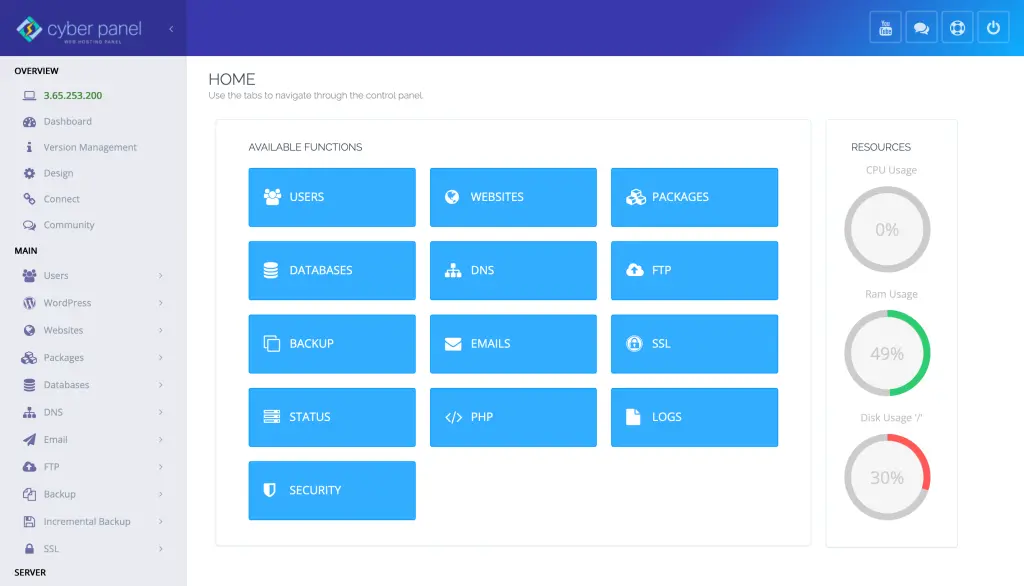What if you’ve got your app running in a Kubernetes cluster, but how can you reach it from your local machine without having to expose it via something like external services? This is where the beauty of the kubectl port forward command comes into play. By testing microservices, debugging any problem, or just tailing logs, the tool provides a quick and secure channel between a local environment and an internal cluster.
With kubectl port-forward, developers are able to forward traffic from a port on their local machine to a port on a Pod or Service in Kubernetes. This comes in especially handy as you develop and troubleshoot, only needing temporary access.
In this article, we will delve into all aspects of the kubectl port forward functionality, from how you can use the feature with Pods and Services, common use cases, errors, and best practices. We’ll also discuss how this tool works with the larger Kubernetes ecosystem and how CyberPanel can integrate with Kubernetes-native systems, along with its capabilities.
And let’s get right into it and become Kubernetes port forwarding masters!
What Is kubectl port-forward and When to Use It?
kubectl port forward provides functionality to forward ports on a local machine to a Kubernetes cluster. It is a useful and powerful tool for accessing applications running inside the cluster without providing public access or changing any firewall or ingress settings.
How it Works:
Get exclusive access to all things tech-savvy, and be the first to receive
the latest updates directly in your inbox.
- You run the command locally.
- It securely connects to the K8s API server.
- Forwards local port traffic to the remote resource (Pod/Service).
How to Use kubectl port-forward with a Pod?
You can forward a local port to a port on a specific Pod using its name and namespace. It’s useful for testing applications running in isolated environments.
Syntax:
kubectl port-forward pod/<pod-name> 8080:80 -n <namespace>
Example:
kubectl port-forward pod/my-nginx-123456 8080:80 -n default
Output:
Forwarding from 127.0.0.1:8080 -> 80
Now you can open http://localhost:8080 to access the app.
How Do You Use kubectl port forward Service?
kubectl port forwarding allows load-balanced access to backend Pods through a stable service name, ideal for stable testing environments.
Syntax:
kubectl port-forward service/<service-name> 9090:80 -n <namespace>
Example:
kubectl port-forward service/my-service 9090:80 -n default
This connects your local port 9090 to port 80 of the Service named my-service.
Common Use Cases of kubectl port-forward
| Use Case | Description |
|---|---|
| Debugging | Test internal microservices locally |
| Health Checks | Access health endpoints without exposure |
| CI/CD Integration | Temporarily access internal endpoints for automation |
| Security Compliance | No need to expose internal ports via LoadBalancer or NodePort |
| Database Access | Connect to internal PostgreSQL, Redis, etc. for testing |
Best Practices:
- Use short-lived sessions.
- Always specify the namespace.
- Avoid hardcoding port numbers in scripts.
- Close the session after use to free up resources.
- Use
--address 0.0.0.0carefully—restrict to localhost if possible.
Common Errors in kubectl port forward and How to Fix Them
| Error Message | Cause | Solution |
|---|---|---|
Unable to listen on port | Port already in use on local machine | Use a different local port |
error: unable to upgrade connection | Pod is crashing or restarting | Restart Pod or check container logs |
Connection refused | Wrong target port or Pod is not ready | Verify Pod status and correct port number |
403 Forbidden | RBAC not configured | Assign proper port-forward permissions to user |
Role of CyberPanel

CyberPanel is a robust web hosting control panel, but in recent times, it has also started to become popular in the Kubernetes community:
- Support for managing domain names and DNS for Ingress Services
- Push app images to the container registry common to clusters
- Auto-generate SSL & Config files to interact with the external K8 service
- Supports Kubernetes-ready container-based WordPress installations
By combining a developer-friendly toolkit with Kubernetes-native operations, CyberPanel provides web hosting to cloud orchestration for a less jarring and more approachable experience.
FAQs
Can I use kubectl port forward with deployments?
No, port-forwarding is only possible with Pods/Services. Find a Pod from the deployment with kubectl get pods
Is traffic encrypted in kubectl port forward?
Yes. Traffic is securely tunneled through the Kubernetes API server.

Is it possible to use the background feature for the port forwarding?
Yes, you can run it with & in Unix or use nohup for persistent sessions.
Does port forwarding remain after closing terminal?
No. Once the terminal is closed, the port forwarding ceases.
Final Thoughts!
When you’re testing apps in Kubernetes, speed and security are important. Enter the kubectl port forward command, which provides one of each: no exposure, no risk, and no fuss. It’s a short path to immediate access to your cluster yourself as a developer.
Start using kubectl port forward today and simplify your Kubernetes experience like never before!



